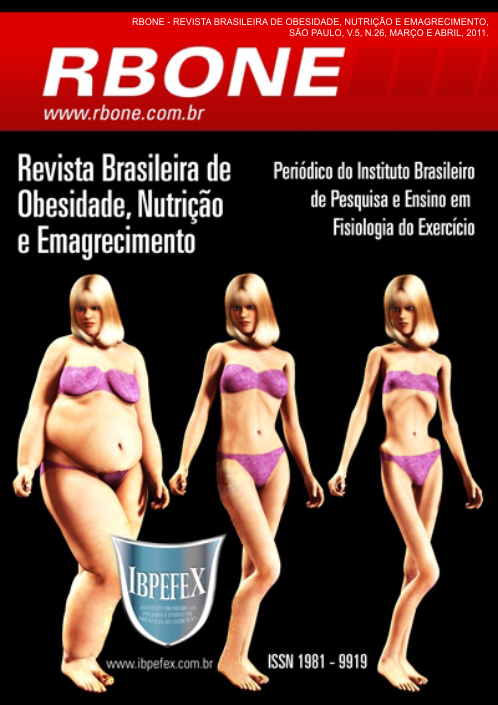Down syndrome and its pathogenesis: key features and their nutritional approach
Abstract
Down syndrome is agenetic conditionand that is one of the most common causes of mental retardation in Brazil. The specific nutritional needs of people with Down Syndrome are little studied. The food problems are related to congenital abnormalities such as muscular hypotonia, and thyroid disorders. This paper presents results of a survey that aimed to identify difficulties related to the need of the syndrome and nutritional deficiencies. The study involved 42 parents were employed research methodusing a questionnaire that was applied in a group with questions about alternative food among other features: consistency / food-related illnesses, difficulty in chewing, encouraging autonomy, behavior toward food and eating habits. Data were presented as frequencies and percentages, where 45% of the sample are above the appropriate weight and 41.8% too high, related to consumption o fun healthy foods was obtained that 40.5% consume fourtimes as odaweekor more 54.8% of parents stillhave difficultys etting limits on food and 47.6% use food as black mail orreward. Subject to the need for the intervention and lack of nutrition education for action aimed att his audience, was raised the need for more attention and scientific studies aimed at this target group proposed a nutritional care and monitoring specificto them.
References
-Amabis, J.M.; Martho, G.R.; Otto, P.A. Biologia e Saúde Humana. São Paulo: Moderna, 1981, p. 120-125.
-Boog, M.C.F. Dificuldades encontradas pormédicos e enfermeiros na abordagem de problemas alimentares. Rev. de Nutrição, Campinas, Vol. 12, Núm. 3, 1999a, p. 3-5.
-Cervato, A.M.; Gomes, A. L. C.; Jorge, M. I.E. Bases teóricas para a prática da educação nutricional. Rev. Nutrição em Pauta, São Paulo, Vol. 12, Núm. 67, 2004, p. 12-17.
-Cohen, W.l. Health Care Guidelines for individuals with Down Syndrome: Revision. Down Syndrome Quartely, Vol. 4, Núm. 3, 1999, p. 1-18.
-Coelho, A. L. Produção de materiais didáticos para educação básica -geografia, ciências e educação ambiental, 2008, p.1-2. Departamento de Psicologia e Educação/ Monografia disponível em: http://www.usp.br/prc/aprender acessado em 10/09/2011.
-Cotran, R.S.; Kumar, V.; Robbins, S.T. Patologia Estrutural e Funcional. Rio de Janeiro: Guanabara Koogan. 4ª edição, 2005, p. 139-140.
-Escott-Stump, S.; Mahan, L.K. Alimentos, Nutrição e Dietoterapia. São Paulo: Roca, 8ª edição. 2005, p. 89-112.
-Fagioli, D.; Nasser, L.A. Educação Nutricional na infância e adolescência: planejamento, intervenção, avaliação e dinâmicas. São Paulo: RCN, 2006, p. 89-112.
-Furkin, A.M.; Santini, C.S. Indicação e seleção da dieta alimentar para pacientes disfágicos: Uma questão de sobrevivência. Rev. de Fonoaudiologia, ano 4, Vol. 6, 2004, p. 6-8.
-Garcia, R.W. Um enfoque simbólico do comer e da comida. Rev. de Nutrição, Campinas, Vol. 2, Núm. 8, 1992, p. 70-80.
-Marcondes, E. Crescimento Normal e Deficiente. São Paulo. Sarvier, 3ª edição. Vol. 1, 1989, p. 99-100.
-Mello, E.D.; Luft, V.C.; Ferraro, S.D. Supervisão em saúde: Aspectos e Manejo Nutricional. Rev. Nutrição em Pauta, São Paulo, Ano 14, Núm. 78, 2006, p. 19-23.
-Moreira, L.M.A.; Charbel, N.; Gusmão, F.A.F. A Síndrome de Down sua patogênese: considerações sobre o determinismo genético. Rev. Brasileira de Psiquiatria, São Paulo, Vol. 22, Núm. 2, 2000, p. 2-3.
-Musaiger, O. A.; Gregory, W. B. Dietary Habits of School-Children in Bahrain The Journal of the Royal, Society for the Promotion of Health. Vol. 112, Núm. 12, 1992, p. 159-162.
-Nisihara, R.M.; Kotze, L.M.; Utiyama, S.R.; Oliveira, N.P.; Fiedler, P.T.; Messias R.I.T.; Ferreti, F. Doença celíaca em crianças e adolescentes com SD. J. de Pediatria, Vol. 81, Núm. 5, 2005, p. 5-7.
-Nisihara, R.M.; Oliveira, N.P.; Fielder, P.T. Alterações do TSH em pacientes com SD: uma interpretação nem sempre fácil.J. compilation Pediatrics and Child Health, Royal Australasian College of Physicians, Rio de Janeiro, Vol. 42,Núm. 5, 2006, p. 3.
-Ribeiro, L. M.A.; Jacob, C.M.A.; Pastorino, A.C.; Kim,C.A.E.; Fomim A.B.F.; Castro, A.P.B.M. Avaliação dos fatores associados a infecções recorrentes e/ou graves em pacientes com síndrome de Down, J. Pediatria. Vol. 79, Núm. 2, 2003, p. 8-12.
-Santos, J.A.; Franceschini, S.C.C.; Priore, S.E. Curvas de crescimento para crianças com SD. Rev. Brasileira Nutrição Clínica, Vol. 21, Núm. 2, 2006, p. 144-148.
-Silva, D.L.; Santos, J.A.R.; Martins, C.F. Avaliação da composição corporal em adultos com SD. Rev. de Nutrição, Campinas, Vol. 20, Núm. 4, 2006, p. 103-110.
-Silva, M.F.M.C.; Kleinhans, A.C.S. Processos cognitivos e plasticidade cerebral na SD. Rev. Brasileira de Educação Especial, Marília, Vol.12, Núm. 1, 2006, p. 5-15.
-Silva, N.L.P.; Dessen, M.A. Crianças com SD e suas interações familiares. Estudo Psicol. Reflex. Porto Alegre, Vol. 16, Núm. 3, 2003, p. 2-20.
-Toral, N.; Slater, B. Abordagem do modelo transteórico no comportamento alimentar. Ciênc. saúde coletiva, Rio de Janeiro, Vol. 12, Núm. 6, 2007, p. 6-10.
-Vivone, G.P.; e colaboradores Análise da consistência alimentar e tempo de deglutição em crianças com paralisia cerebral tetraplégica espástica. Rev. CEFAC, São Paulo, Vol. 9, Núm. 4, 2007, p. 7-8.
Authors who publish in this journal agree to the following terms:
- Authors retain the copyright and grant the journal the right of first publication, with work simultaneously licensed under the Creative Commons Attribution License BY-NC which allows the sharing of the work with acknowledgment of the authorship of the work and initial publication in this journal.
- Authors are authorized to enter into additional contracts separately for non-exclusive distribution of the version of the work published in this journal (eg, publishing in institutional repository or book chapter), with acknowledgment of authorship and initial publication in this journal.
- Authors are allowed and encouraged to post and distribute their work online (eg, in institutional repositories or on their personal page) at any point before or during the editorial process, as this can bring about productive change as well as increase impact and impact. citation of published work (See The Effect of Free Access).






